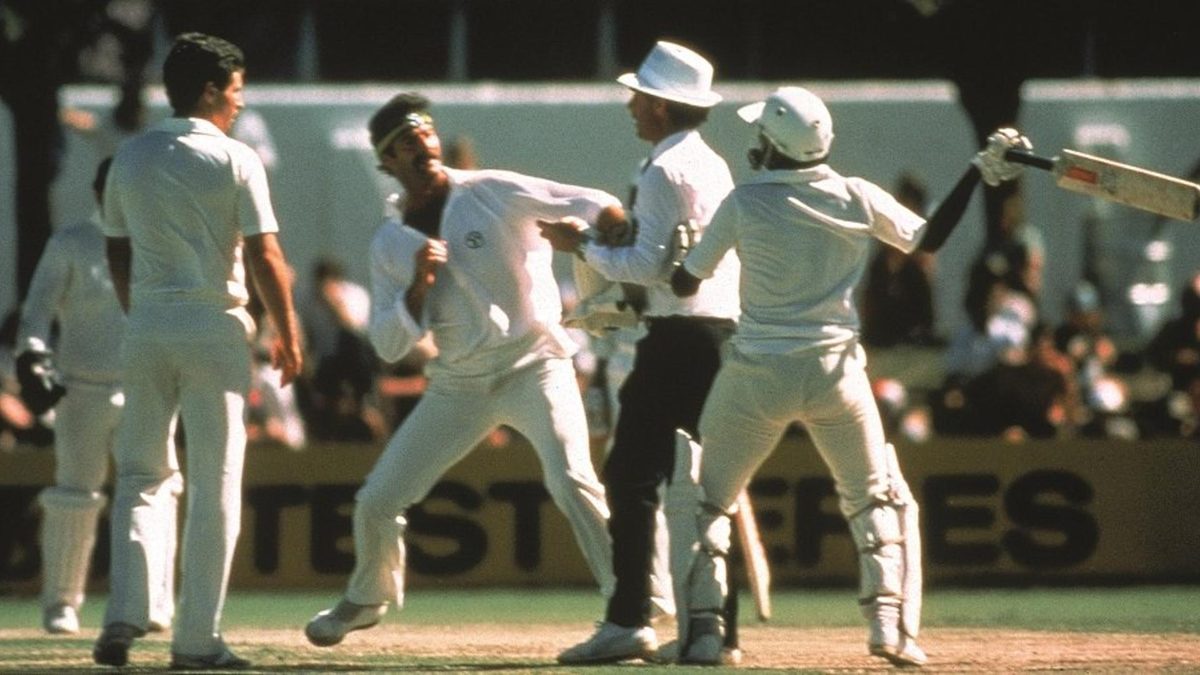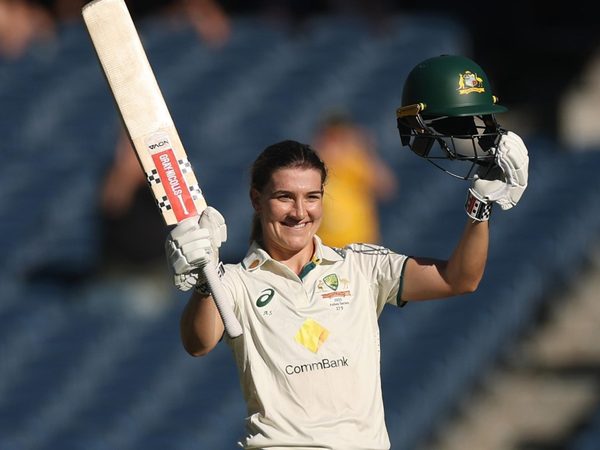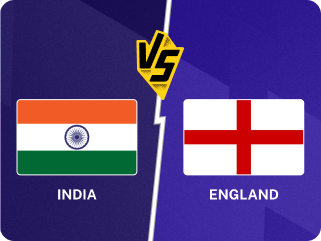
From the infamous underarm incident to the Lillee-Miandad tussle, Ed Davis, Richard Dawson, Phil Walker penned down ten acts of skulduggery.
Published in 2008
Published in 2008
1. Steve Waugh v West Indies, Barbados 1999
On this list you’ll find more obvious tales of naughtiness, more clear-cut examples of wilfully bad form – no question that cricket has been dragged through the mud in dirtier circumstances than this. But for sheer unvarnished cheek and calculated skulduggery, Stephen Waugh’s claiming of a catch at Barbados against Brian Lara, in the most important Test series of the Nineties, makes it to the top of our charge sheet.
It happens on the first day of a Test series that would come to shape the five-day game’s future. Barbados was once a citadel, but this is 1995. Australia are strong, and the home team are mortal. This is the world championship of Test cricket.
Brian Lara’s ripping blade is making up for an early flurry of wickets. It’s enthralling stuff, with the magisterial Lara chanceless. But having whipped and slashed his way to 65, he cuts uppishly hard and just behind square, where Waugh, a great gully fieldsman, moves instinctively to his right.
At 165-5, West Indies need Lara to deliver in a big way. It’s already a critical moment. Anything over 250 will be competitive, but anything under 200 and Australia will boss the match (and then the series, and then, inexorably, the sport itself).
So Lara cuts hard. Waugh’s hands parry the bullet into his midriff. As he falls, his mitts whirr around in a manic scramble to lay claim to the thing, but the ball appears to plop out of his grasp as the body lands, getting lost under his frame. Initially it’s inconclusive. Waugh rolls over and hurls the ball into the air. The catch is claimed. Remember this is the age before third umpire referrals. Lara turns and walks away. We look to the replay, and one look confirms that the ball has clearly, emphatically hit the ground and bounced back up into his grasp.
It is just about possible, just about, that Waugh was unsure if the chance had been grassed or not. It is therefore theoretically possible that, with all doubts wedged to the back of his mind, he thought he’d chance it with the umpire. It’s risible if this is the case, for a catch should only be claimed if the fieldsman is absolutely sure of its legitimacy. But this is cricket. It happens.
But even to suggest he wasn’t sure is to give him the benefit of oceans of doubt. We are always told that cricketers intuitively know when a catch is ‘clean’, and when it’s not, even for those catches when the ball seems to graze the turf at the exact same moment as the fingers clasp around it. A cricketer, we are told, just knows. So it takes an almighty effort to reject the sense that Waugh, in that brief befuddled moment when he knew he’d dropped the man Lara, just couldn’t resist pickpocketing the wicket anyway.
It works. The umpire is duped, and as Lara traipses off, the outcries echo from Barbados to Barbuda. Waugh is now not so much a cricketer, as a stone-eyed poncho-clad bounty hunter rolling into town to bag Brian The Kid.
The West Indians lose the match, and Waugh’s actions provide a suitable outlet for their fears and frustrations. In response the lynch mob – Walsh, Ambrose, the Benjamin boys – get tooled up and go out into the night, hitting him with bumper barrages, verbal shrapnel, bile, even the odd satanic smile. Sheriff Ambrose, especially, is consumed by the injustice of it all, and spends the next three Tests firing at Waugh’s head before following through to within an inch of his face.
As for Waugh himself, he’ll look out across those desolate Aussie planes, his fighting days over, and tell you that without that onslaught from those West Indians, he would never have burned to make that definitive double ton at Antigua – the only one of his career – that sealed the series and made the man. He’ll also deny ever claiming a false catch in his life. Then he’ll take another swig from his hip flask of sour mash, and spit it out on the tail of a scuttling lizard.
– PW
As part of our #1990sInReview series, @Phil_Wisden, @SternWords and Graham Thorpe joined @Yas_Wisden on the @WisdenCricket Weekly podcast to pick out Wisden’s Test team of the 1990s.
Here’s the XI they ended up with:https://t.co/5YTXJMcfDC
— Wisden (@WisdenCricket) November 22, 2020
2. Trevor Chappell v New Zealand, Melbourne 1981
On February 1 1981, in an ODI between Australia and New Zealand, cricket’s single lowest act took place. The action prompted New Zealand’s then-prime minister, Rob Muldoon, to call it “the most disgusting incident I can recall in the history of cricket” and “an act of cowardice”. His Australian counterpart Malcolm Fraser conceded it was “contrary to the traditions of the game”.
It was the final of the B&H World Series Cup at the MCG and it was building up to a great finish. The Kiwis were chasing down Australia’s 235, and a Bruce Edgar century had left them needing 15 off the last over. Trevor Chappell was given the responsibility of sealing the game for the Aussies.
In an over containing a couple of big hits from Richard Hadlee and wicketkeeper Ian Smith, along with two wickets, the Kiwis had got to the last ball of the game needing six runs to tie the game. The authorities dream of finishes like this, but what happened next would give them nightmares.
Figuring that a six can only be achieved if the ball is airborne when it’s hit, Australia’s evil genius captain Greg Chappell instructed his younger brother Trevor to bowl underarm to the Kiwi number ten Brian McKechnie.
Being the younger brother, the inferior player and the captain’s underling, Trev didn’t stand a chance. Indeed the whole scene resembled a school playground, with the school bully browbeating the class geek into ruining everyone else’s fun.
Apart from the famously hard-nosed Greg, no one wanted this to happen; even as Trevor shuffled up to the crease, the Aussie wicketkeeper Rod Marsh was shaking his head to try and prevent him doing the unthinkable. But it was too far gone. Trev knelt at the crease, bent down, and gently rolled the ball along the floor. McKechnie, a former All Black, dead batted the ball and then threw his bat away in disgust.
The younger Chappell snatched his hat from the umpire and stormed off the pitch. Maybe he was embarrassed. Maybe he was furious at being pushed around by a scheming older brother. Or maybe, it was the grim realisation that his association with cricket’s most cowardly act of unsporting skulduggery would muddy his name forever.
– RD
3. Inzamam-ul-Haq v India, Toronto, 1997
This was cricket’s Cantona moment, and proof that even the mildest characters can be provoked into retaliation.
In this instance, Inzamam-ul-Haq, usually a gentle giant, got the red mist. India were playing Pakistan in Toronto in an ODI and an Indian fan was continuously baiting Inzy with potato comments, referring to him as ‘Aloo’, and laying into his religious beliefs, all conducted through a megaphone. How the fan got away with it is anyone’s guess, but the smart arse certainly got to the usually sedate Inzy, and roused the great man; his response was wrong but majestic.
With Pakistan fielding, Inzy called for the twelfth man to bring out his bat, and after receiving it, smashed it on the ground like it was a medieval pre-fight ritual, and marched into the stands to seek out his target. A man possessed, his actions whipped an already wild crowd close to hysteria, and if he’d found his man, only Allah knows what might have happened. Fortunately for the heckler Inzy didn’t land a knockout blow as security and team-mates managed to hold him back, but the game was held up for 40 minutes amid some of the most riotous scenes ever seen at an international cricket match.
".="" inzamam="" vs="" an="" indian="" spectator="" !="" full="" incident"="" width="500" height="281" src="https://www.youtube.com/embed/zsn_NCiMlyA?feature=oembed" frameborder="0" allow="accelerometer; autoplay; clipboard-write; encrypted-media; gyroscope; picture-in-picture; web-share" referrerpolicy="strict-origin-when-cross-origin" allowfullscreen="" class="lazy">
– RD
4. Viv Richards v England, Barbados 1989
We all grew up with the adage ‘you can’t change the umpire’s decision’ ringing in our ears. And we always adhered to it. But for the special ones, like Sir Isaac, normal rules were there to be bent. We’re talking here about a lad who once refused to leave the crease in a youth team game after being given out, and was reinstated to avoid any more hassles – such was the power the kid was already exerting on West Indian cricket.
What happened at the Kensington Oval, Barbados, in 1989, with England chasing a surprise victory, was another classic example of the Richards factor. Rob Bailey was at the crease late in the evening facing Curtly Ambrose in full flow with the crowd at fever pitch. When one of the deliveries skirted Bailey’s thigh pad on its way through to wicketkeeper Jeffrey Dujon, the slip cordon went up in unison, and with Viv the rowdy ringleader, up went the partisan crowd. Nothing strange there.
Initially, when umpire Lloyd Barker’s finger didn’t go up, for the simple reason that Bailey didn’t hit it. Viv took matters into his own hands. After a little friendly persuasion, in the form of Richards running from first slip all the way to mid-on wildly wagging his finger and doing his best lassoing motion with his arm, Barker eventually puts his finger up, much to the amazement of Bailey and Alec Stewart at the non-striker’s end. Richards had flexed a bit of muscle – that was all it took.
Viv later said that it was up to the umpire to retain his composure and make his decision…
– RD
5. John Snow v Australia, Sydney 1971
Back in the days when sport was played for sport’s sake – and when cricket was played with as little padding as people dared – the son of a Church of England preacher man was ruffling a few feathers Down Under.
In 1971, at the SCG, John Snow, middle name Augustine but certainly no saint, was causing havoc on and off the pitch. The Sussex fast bowler had hit Terry Jenner, the Aussie leggie, on the head and sent him crashing to the canvas.
His nonchalant attitude after the incident riled the Australian crowd, and fuelled-up fans were out of their seats to show exactly what they thought of this type of aggressive approach. Much to the dissatisfaction of Ray Illingworth, the England captain, umpire Rowan warned Snow for the bouncer.
Snow made his way to his fielding position on the boundary below the Paddington Hill, within touching distance of the irate crowd. With the injured Jenner still being helped off the pitch, one fan leant over the fencing and grabbed at Snow’s arm.
He pulled away but the fan clung on, and that’s when things turned ugly. The drunk then took a slap at Snow’s face and was eventually hauled back by other fans stood next to him. The scene turned into something more akin to a bar room brawl. Beer cans and bottles began to rain down onto the area where he was fielding. A young Bob Willis came to the rescue and pulled the Sussex bowler away.
Illingworth, showing his Yorkshire grit, summed up the situation in an instant and marched his team off the pitch with fears for their safety in mind. In doing so, the canny old blighter ensured this dark day for Australian cricket would never be forgotten.
After ground staff cleared the cans off the playing area the umpires warned Illingworth that the game would be awarded to Australia if he didn’t lead his team back on to the ground. Eventually they returned, with Willis taking Snow’s position down on the boundary.
The Poms went on to regain the Ashes, and Snow finished with 31 wickets; not bad when you consider England weren’t awarded a single LBW decision.
– RD
6. Sunil Gavaskar v Australia, Melbourne 1981
This was the ultimate, ‘I’m taking my ball and not playing any more’ moment. Sunil Gavaskar was enduring a wretched run of form during India’s tour of Australia, with the moustachioed maestro Dennis Lillee seemingly able to dismiss him in his sleep.
Gavaskar’s mental state was not helped by the fact that he felt his side had been getting a raw deal from the home umpires (never!), with the decisions of the inexperienced Rex Whitehead a particular issue. By the final game of the three-match series, Sunny, never the most shy and retiring bloke, was seething.
Having fought his way to a dogged 70 during an opening stand of 165 alongside Chetan Chauhan, Lillee jagged one back into his pads – up went the bowler and up went Whitehead’s finger.
But Gavaskar stood his ground. He’d inside-edged it. Lillee, ever the diplomat, decided to indicate exactly where the ball had struck the Indian captain, all the while offering his unique brand of observation concerning his integrity, technique and parentage. Eventually Gavaskar started to walk, but Lillee made one comment too many and Sunny snapped. Marching back to the wicket, he beckoned for Chauhan to follow him, and stomped off with his poor old junior partner vaguely in tow.
The retreating duo were met at the boundary edge by the Indian management. Chauhan was told, in no uncertain terms, to get back out there, whilst Gavaskar was quickly ushered into the pavilion. Chauhan, who had been in full flow, was out mere moments later.
“I was infuriated by the injustice of it all,” Gavaskar told reporters. “Whitehead has stood in all three Tests and many bad decisions by him have gone against us.”
Lillee, unsurprisingly, had a different view, saying Gavaskar simply “spat the dummy right out of the pram.” Noted cricket writer Peter McFarline took a similarly dim view, describing it as “the Test that could have died of shame.”
– ED
7. Dennis Lillee v Javed Miandad, Perth 1981
Lillee versus Miandad was always likely to be spicier than a vindaloo with Mel B and her mates. As two of the era’s most high-profile players, neither was very fond of losing, and neither was capable of a backward step.
Pakistan found themselves two down chasing a nominal 543 when Miandad came out to bat at Perth in the first Test. Lillee was bowling rockets, but Miandad and Mansoor Akhtar knuckled down, and by playing watchfully and running the singles hard, they began to build a partnership.
It was during one of these singles that things got a bit out of hand. What is certain is that Lillee and Miandad collided. Most observers agreed that Dennis deliberately got in Javed’s way. Subsequently Lillee has claimed that Miandad struck him from behind with his bat, whilst Miandad says the Aussie kicked him as he passed: tit for tat.
But after grappling in the playground, the boys tumbled into the sandpit. Lillee whirled round to confront the Pakistan captain, only to find Miandad charging at him, wielding the willow like he’s auditioning for Arnie’s part in Conan. The sight of umpire Tony Crafter separating the pair and threatening to tell their mums if it happens again is one of the most unedifying (and hilarious) images in cricket history.
https://www.youtube.com/watch?v=4sfg3CK4PN8&t=15s
The incident actually divided the Chappell brothers, with Ian describing Lillee’s actions as those of a “spoiled, angry child”, whilst Greg, Australia’s captain, rounded on his opposite number, arguing that, “what Miandad did was the most disgraceful thing I have seen on a cricket pitch.”
– ED
8. Michael Holding and Colin Croft v New Zealand, 1979/80
The Windies arrived in New Zealand following an exhausting Test series victory over Australia, and after beating England in the final of the B&H World Series. They were knackered.
After, surprisingly, struggling against the Kiwis in the first Test at Dunedin, the Windies received the first of many decisions that drove them to distraction. Michael Holding was convinced that John Parker had nicked behind, but umpire John Hastie disagreed. Holding advanced down the track, paused, and then scythed down the stumps with one graceful arc of his size 13. Another dubious decision on the third day of the second Test by Fred Goodall almost led to the West Indies quitting the country. Worse was to follow.
https://www.youtube.com/watch?v=lOscUoF7ytg&t=28s
Colin Croft had a belated appeal for yet another caught behind turned down by Goodall, and responded with a particularly violent salvo of Anglo-Saxon. He then unleashed a series of bouncers at the bemused Richard Hadlee, which prompted Goodall to start no-balling him. Croft replied by knocking the bails off as he walked back to his mark, and then commenced his customary hurtle towards the crease from directly behind the umpire. Only this time he didn’t make any attempt to alter his course, and simply crashed into Goodall in the least disguised shoulder charge in history.
– ED
9. Shahid Afridi v England, Faisalabad 2009
England found themselves three down and struggling to overhaul Pakistan’s impressive first innings total of 462 when all hell broke loose.
A gas canister exploded in the stands, which understandably, in a country run (at the time of writing) by Gen Musharraf, caused some consternation and a halt in play. It was at this point that Shahid ‘Boom Boom’ Afridi decided to take advantage of the confusion, and crept off towards the square.
His bizarre pirouetting routine to rough up a beauty of a pitch wasn’t exactly cloaked in subtlety, performed as it was in full view of the cameras. To the man’s credit, he promptly apologised for what he described as a ‘moment of madness’ and pleaded guilty to breaching the ICC code of conduct.
Afridi was banned for a Test and two one-day internationals, and has since confined his madness to his particular brand of brutal and brutally flawed strokeplay and canny leggers.
– ED
10. Shaun Udal v Cranleigh, Surrey Championship 2003
Many a time has a professional cricketer, in trying to get a little practice on a Saturday afternoon, been wound up playing for his club side by a chippy amateur cricketer who thinks he’ll test the patience of the pro. Never has this been more evident than with the thoroughly likeable, easy-going Shaun Udal. Talk about the unexpected on a cricket pitch.
The recently retired Hampshire off-spinner received a three-year ban from club cricket whilst playing in the Surrey League for Camberley after a fracas with one of Cranleigh’s players.
Udal retaliated after one of his team-mates was insulted by one of the opposition (an Aussie, wouldn’t ya know), which, for our cash, is the definition of a team player. Udal claimed there was no fighting and insisted no punches were thrown. Unsurprisingly, Cranleigh’s version of events were a little different. We’re with you Shaggy.
– RD








